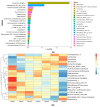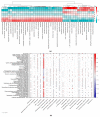Changes in Gut Microbiota Associated with Parity in Large White Sows
- PMID: 38200843
- PMCID: PMC10778104
- DOI: 10.3390/ani14010112
Changes in Gut Microbiota Associated with Parity in Large White Sows
Abstract
As one of the most critical economic traits, the litter performance of sows is influenced by their parity. Some studies have indicated a connection between the gut microbiota and the litter performance of animals. In this study, we examined litter performance in 1363 records of different parities of Large White sows. We observed a marked decline in TNB (Total Number Born) and NBH (Number of Healthy Born) We observed a marked decline in TNB (Total Number Born) and NBH (Number of Healthy Born) among sows with parity 7 or higher. To gain a deeper understanding of the potential role of gut microbiota in this phenomenon, we conducted 16S rRNA amplicon sequencing of fecal DNA from 263 Large White sows at different parities and compared the changes in their gut microbiota with increasing parity. The results revealed that in comparison to sows with a parity from one to six, sows with a parity of seven or higher exhibited decreased alpha diversity in their gut microbiota. There was an increased proportion of pathogenic bacteria (such as Enterobacteriaceae, Streptococcus, and Escherichia-Shigella) and a reduced proportion of SCFA-producing families (such as Ruminococcaceae), indicating signs of inflammatory aging. The decline in sow function may be one of the primary reasons for the reduction in their litter performance.
Keywords: gut microbiota; litter performance; parity; sows.
Conflict of interest statement
Author Jinglei Si was employed by Guangxi State Farms Yongxin Animal Husbandry Group Co. Ltd. The remaining authors declare that this research was conducted in the absence of any commercial or financial relationships that could be construed as a potential conflicts of interest.
Figures





Similar articles
-
Identifying SNPs and candidate genes for three litter traits using single-step GWAS across six parities in Landrace and Large White pigs.Physiol Genomics. 2018 Dec 1;50(12):1026-1035. doi: 10.1152/physiolgenomics.00071.2018. Epub 2018 Oct 5. Physiol Genomics. 2018. PMID: 30289746
-
Effect of birth litter size, birth parity number, growth rate, backfat thickness and age at first mating of gilts on their reproductive performance as sows.Anim Reprod Sci. 2001 May 31;66(3-4):225-37. doi: 10.1016/s0378-4320(01)00095-1. Anim Reprod Sci. 2001. PMID: 11348784
-
Comparison of Gut Microbiota and Metabolic Status of Sows With Different Litter Sizes During Pregnancy.Front Vet Sci. 2021 Dec 23;8:793174. doi: 10.3389/fvets.2021.793174. eCollection 2021. Front Vet Sci. 2021. PMID: 35004929 Free PMC article.
-
Shifting sows: longitudinal changes in the periparturient faecal microbiota of primiparous and multiparous sows.Animal. 2021 Mar;15(3):100135. doi: 10.1016/j.animal.2020.100135. Epub 2020 Dec 26. Animal. 2021. PMID: 33573959
-
Selecting for changes in average "parity curve" pattern of litter size in Large White pigs.J Anim Breed Genet. 2019 Mar;136(2):134-148. doi: 10.1111/jbg.12372. Epub 2018 Dec 26. J Anim Breed Genet. 2019. PMID: 30585650
References
LinkOut - more resources
Full Text Sources
Research Materials

